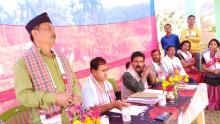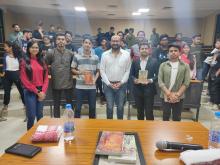Assamese Scientist discovers pathway to curb viral diseases
A good number of students, researcher and scientists from the northeastern part of the country engaged in different fields, acquired tremendous achievements in foreign countries. Very recently an Assamese scientist working in USA, has shown a new path that can help cure any viral disease like influenza, herpes or HIV. Dr. Ankoor Roy and his colleagues’ achievement has been recognized worldwide by Structure, a prestigious scientific journal.
In an interview Dr. Roy said they used P22 bacteriophage as a model system for the research. The researcher and his team have identified small protein which plays a critical role in identifying its own DNA and pumps its own DNA to form a new virus particle inside the host cell. Structure solved by them will help to design drugs against herpes and HIV virus as they also have the same mechanism and protein. This will ultimately help to stop the recognition event of its own DNA and multiplication the virus particles inside the host. It is to be mentioned that understanding the viral life cycle is very important to develop drugs against them. Till now there is no cure for any viral disease, like influenza, herpes or HIV. Most of the studies are directed towards understanding the life-cycle of virus.
Dr. Roy who graduated from Gauhati University and is now working in Department of Biotechnology and Molecular Biology at Thomas Jefferson University in Philadelphia says both bacteria and viruses are very small, but bacteria, given the proper nutrients, can grow and produce on their own. Viruses cannot “live” or reproduce without getting inside some living cell, whether it’s a plant, animal, or bacteria. Bacteriophage is virus that looks like an alien landing pod. With its six legs, the bacteriophage attaches to the surface of the much larger bacteria Escherichia coli (E. coli). Once attached, the bacterophage injects DNA into bacterium. The DNA instructs the bacterium to produce masses of new viruses and so many are produced that the E. coli bursts. Because of the similarities between bacteriophage and animal cell viruses, bacteriophage (P22) is viewed as a model system, Roy said. Dr.Roy is the only son of Mr. Hemendra Kumar Roy and Mrs. Tarudevi Roy residing at Shantipur (Guwahati) in the state of Assam, India. His wife Dr. Monalisa Majumdar is a Research Engineer at L. G. IRIS in USA and co-incidentally the protein structure illustrated by Mrs Majumdar takes place on the cover page of the journal “STRUCURE”..
The team used a bottom up approach where they identified and determined the structure of a small protein crystallography, which is responsible for identifying its own DNA from the pool of bacterial DNA. This work is very significant from the point of understanding the biology of virus and deigning drugs against it.
Random Stories
1 Aug 2014 - 10:59am |
AT News
Dissident camp is meeting on Saturday in Dispur to fine tune their strategies in the Assam Assembly. But they are unlikely to create any scene on the floor from Monday. The dissident legislators led...
26 Nov 2017 - 5:54pm |
Akshaya Pranab Kalita
NAMRUP: More than 600 people in a remote hamlet in Namup have reasons to smile. Courtesy Naharkatiya MLA Naren Sonowal. Decade long potable water crisis no longer would put these villagers in dire...
30 Aug 2007 - 4:13am |
BandanBharadwaj
Dhubri : A top ULFA leader has been reportedly killed in an encounter with security forces at Motirkuta sub locality under Gouripur in Dhubri district.Security forces patrolling the area noticed a...
13 Mar 2023 - 8:09am |
AT News
On 11th March 2023, the Indian Institute of Information Technology Guwahati (IIITG) hosted a literary panel discussion on the topic of "A fulfilling life - have a well-paying career, pursue a passion...
Other Contents by Author
Wildflowers, the birdwatchers' group of Centre for Conservation, Education and Research, counted more than two thousand Amur Falcons at Borbori in Morigaon district on October 29th. The bird arrived in Morigaon district last week and could be seen perching on the High Transmission wires. Thousands of the migratory Amur Falcons have arrived for roosting at hilly forest terrains of Karbi Anglong and Morigaon districts on their way from Mongolia, north China and Siberia to Africa. Mubina Akhtar, a conservation activist and director of CCER says "The Amur Falcon (Falco amurensis), formerly known as Eastern Red-footed Falcon, is a small raptor of the falcon family and this is for the firsttime...
A team of experts from ICIMOD (International Centre for Integrated Mountain Development, Kathmandu, Nepal) have installed flood early warning systems (FEWS) enabled by wireless technology along the Jiadhal and Singara rivers in Assam, India. The installation was carried out under the Himalayan Climate Change Adaptation Programme (HICAP) and is intended to minimize the flood risks and enhance the adaptive capacity of the communities. Before being installed, the FEWS were tested for six months at the ICIMOD Knowledge Park at Godavari in the Kathmandu Valley, Nepal. Two main lessons can be drawn from the Mahakali and Uttarakhand flood disasters: The severity of the disaster could have been...
No doubt, it is one of the most beautiful places in the state of Assam, India. Lampi or Langpih—as the Khasi people calls it—is a hamlet cradled in the hilly terrains of Assam bordering Meghalaya,a neighbouring state. Surrounded by hills where the humming of cascading streams fills the silence, Lampi is yet to witness the boons and banes of a modern life. So pollution, thankfully, is absent. But also absent are the basic amenities like health services, schools, electricity, good cooking fuel, sanitation and nutrition that deprive its residents of the rights which are constitutionally guaranteed to them. With a population of about eleven thousand, mostly Nepalis and Khasis, Lampi falls...
Poisoning rhino horns may be the best measures in Kaziranga National Park (KNP) to check unabated rhino poaching and save the species in the brink of extinction. Since rhino horn or horn-washed water is consumed mostly in China and Southeast Asian countries as medicine and with some superstition. So if horns of live rhinos be poisoned in live rhinos it will be useless. If someone takes or consumes such poisoned horn, that person will be seriously ill rather than any cure or superstitious feeling. Of course, the poisoning must be in such a way which will not harm the rhino itself and when one rhino squeeze other rhinos.The poisoning method has already been applied to save...
It is not the mainland India, but a little happening Golaghat district in Assam in the nooks of the Northeast where the zero (sunya) originated. Ashok Sarma, a language history researcher with the help of Dr H N Dutta, the former Director of Department of Archeology, Government of Assam and Dr Dharmashwar Chutia, a retired professor of Department of Sanskrit, Gauhati University has established that the numerical zero was first discovered and used in written script by a civilization of Assam between 2nd and 3rd century.The uses of zero happened in Assam long before the birth of both Ayarthabhatta and Brahmagupta, Sarma said. The evidence of the practice of using zero in Assam came to light...
If timely measures are not taken the Muga (Antheria assamensis) heritage of Assam may face extinction in the next three decades or within 2040. The production of famous Muga silk of Assam has not been augmented. The state has a demand of more than than 5000 MT of Muga silk anually, but the state has been producing average 90 MT per year. In 2010-11 the state produced113.28 MT Muga and in 2011-12 this amount was 114.56 MT. According to Sericulture Department sources production in the year of 2013 may be same as the average production, not more.The decline of Som and Soalo plantation areas in government sericulture farms have pushed Muga silk towards the verge of extinction, the report said....
The Balipara Reserve Forest, which was once barren and void of trees, now begins to bring back the greens again by dint of a noble effort of some ex-servicemen of Assam. There has been drastic changes spanning four years in Balipara Reserve Forest of Sonitpur district of Assam. In fact, the district happens to be one of the world’s most deforested districts. Enter Eco Task Force (ETF) of the Ecological Territorial Army, a part of the Indian Army envisages plantation drive for aforestation in devastated areas including the one at Sonitpur district of Assam in the Balipara Reserve Forest.The unit has so far planted 2.8 million saplings, covering an area of 2,750 hectares since September...
Fishery and mustard cultivation may be best adaptation measures as livelihood for flood affected people in Assam. Rice cultivation (Hali Kheti) the main livelihood of people has been affected by flood waters and erosion for years and there has been no exception this year. The state is ravaged by flood waters severely and acres of land are covered with sand carried by flood waters. A study carried out by Center for Conservation Education...
Despite large-scale devastation of cropland and paddy fields in the recent waves of flood followed by erosion, the ex-gratia for flood-affected people covers only house and other property. Flood relief usually does not cover agricultural loss and damage in this part of the country. The measures taken by state agriculture department in also not adequate for the flood-hit farmers. Moreover, the state is not brought under natural calamity mitigation programmse because the union government provides facilities to only drought –hit states.
Rainfall is key to Assam’s agricultural production. However, irregular rainfall is taking a toll on the state’s agricultural produce....
As weeks passed, rumors began to brew. Scientists from the world’s most expensive experiment called Large Hadrons Collider of CERN announced what they claim was the discovery of a “missing” particle that adds mass to matter (the Higgs boson, or so-called God particle). But people don’t want to know the detail of the Higgs. Not yet. They want to know why it is important and how this changes human history.Not only me, the first week of the month of July must have been a bit of a roller coaster ride for science community. Now most of people aware that on July 4th scientists of CMS and ATLAS detectors of Large Hadron Collider (LHC) at CERN, Geneva announced the discovery of a new particle. I...






Add new comment